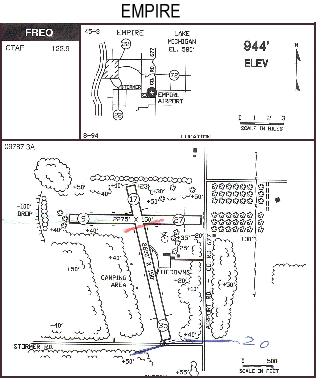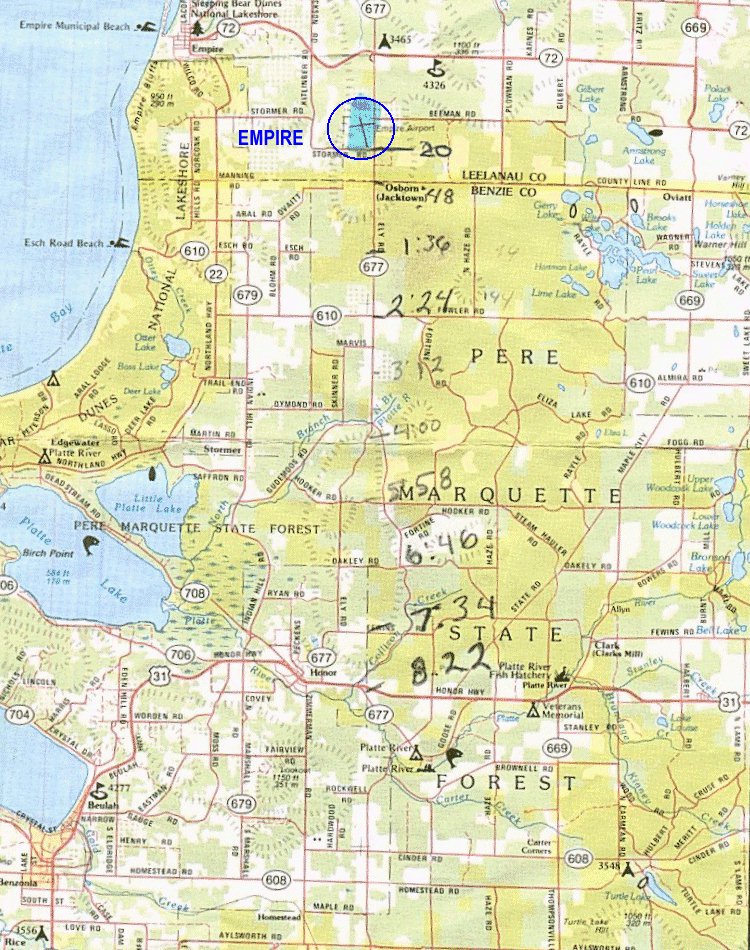|
|
|
|
|
The objective of the rally is to arrive at the destination airports timing line EXACTLY at the time you've calculated it should take. The rally officials will provide you with the distance of each leg to the nearest tenth mile, as well as a current map indicating the exact position of the timing lines at each airport.
As an example, my team, Larry Vihtelic and I, have chosen to fly a ground speed of 75 Knots. With a few turns on the E6B we've concluded we'll be flying at 48 seconds per mile. We then divided 5,280 feet (1 mile) by 48 seconds and find we also are traveling about 110 feet a second. It's a fairly simple matter to find how long the leg should take, but the tip here is in the maps you use to figure the last few miles checkpoints. We start our figuring by using the map contained in the Michigan Airport Directory. In the picture below you'll see Empire, one of the airports we recently flew to. We used the scale on this map and determined it was around 1,900 feet to the timing line from the runway threshold. In this case we were fortunate that there was also a road there we could easily spot. Flying at 100 feet per second, the threshold to the timing line should take us 20 seconds.
 We now move to a map that contains many more details than you'll find in a state sectional map. This one is from a Michigan state map book by counties. You can find these in Wal-Mart in with the magazines. There's also a rack of them in the kitchen utensils area in the South Haven branch for some unknown reason. Looking at the map below will show you where the airport is located as well as most every road in the area. We drew a 20 second out checkpoint on Stormer Rd. which coincided with the threshold and started looking for checkpoints coming into there from the south. Michigan is mostly made of roads a mile apart so it was a simple matter to start adding 48 seconds beginning from Stormer Rd. and marking each road/checkpoint from there. We kind of guessed at where the 1:36 time should place us, We should have been able to find Esch Rd off to our left though. From there on it was fairly easy (should have been anyway).
 Our biggest problem on this leg was in doing our planning well after midnight. We added an extra minute in the figures between 4:00 and 5:58 seconds. We'd just passed through an area where the roads only looked good on the map, down there they were mostly dirt trails winding through the brush. Aside from not finding several roads in the also hilly terain, we were plenty busy trying to figure out what was happening to us. By the time we saw that we were arriving way too early we didn't have the time left to correct all of it. We passed over that timing line with almost full power and as much back elevator as the Piper would tolerate. We finished that leg 20 seconds early. As for timing, we use kitchen timers we found at Wal-Mart. They can be set to any length of time and they count down instead of up beginning with a single button push. We use at least five clocks, one for each leg that we start at the timing line passages. The other two are for total time in case we again stop a clock by accident, and a stopwatch to make sure we're progressing in route at 48 seconds per mile. In the 2001 SMALL Rally we also had problems. We got about four miles out from the first checkpoint and found we were ticking off the wrong cross roads. We arrived at the airport about 20 seconds late after doing all we could to speed up before arriving. We then forgot to start our second leg clock in all the excitement of the fly by. Luckily we had a total rally timer so we could set our second clock back to where it should be as we knew exactly at what time of day we should arrive at the second airport. Our third big mistake we made was in not figuring in the error we made on the first leg, so our restarting the second leg clock guaranteed we would duplicate the error of the first leg even if we thought we were exactly on time. We should have added in the error of the first leg to calculate the new arrival we should have had for the remaining two legs. Every year it seems to be something like this that blows the score out of contention for first place, but we did manage to pull off a fifth place. |
| These tips were generously shared by by the team of Brian Champagne and Andy Janiszewski. Those of us that were touched by Brians passing will forever recall the good times he provided the rally. |
|
|